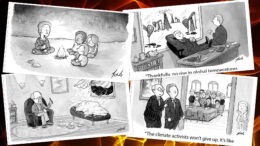Think climate change isn’t funny? Try telling that to cartoonist Tom Toro. The frequent New Yorker contributor, who also writes and draws a comic strip called “Home Free,” often points his pen at the pain and hypocrisy behind the climate crisis and other environmental issues, with blistering results.
It’s not just about mocking the systems and people behind the problems. As Toro tells The Revelator, humor provides worried readers with a laughter-induced catharsis.
At the same time, he points out, humor serves a vital form of resistance.
Platt: This is a tough time for the planet — but also for political cartooning. Most newspapers don’t have staff cartoonists anymore.
Toro: Still, this is a boom time for journalism. There’s plenty of material out there. People are really seeing, more than ever now, the value of the fourth estate and holding power accountable.
Yeah, journalism as the co-equal fourth branch of government. But it’s almost like cartooning should be the fifth branch.
Cartooning is definitely a good part of it. I think people are just really hungry for satire.
It’s tricky, though. You don’t want to minimize things and you don’t want to trivialize. But there’s a way of clarifying an idea in a single panel with a caption. The power, the clarity of that, I think is what’s really appealing.
View this post on Instagram
Cartooning is so well suited to the sort of media diet that people have nowadays. The short captions appeal to kind of the Twitter mentality. It’s just ideally suited to the way that people receive media.
You are always looking for the pithiest caption. Wordiness is kind of the death of a quip. You’ve got to cut like a knife.
But marrying those words with art — how does that shape the satire in comics form?
For the cartoonist — editorial cartoonist, New Yorker cartoonist, whatever — you’re really looking for the stuff that you can attack with the strengths of your own art form. What can I do in a cartoon that they can’t do on Saturday Night Live? That’s the kind of stuff that you really try to hone in on.
Every day I catch up on what Seth Meyers and Stephen Colbert did, and SNL — it’s something funny that we all watch, and everyone kind of attacks the same material. There’s a little bit of repetition that goes into it.
With the cartoonists, it’s like, well, what can I do? Because in cartoons you don’t have to obey physics. You don’t have the sort of constraints of a production of Saturday Night Live. They might shy away from an idea just because it’s not necessarily worth it to create an entire set.
And sometimes those “sets” for you are just a moment in cartoon time.
Yeah. Probably my most popular one was the one that was the sort of postapocalyptic landscape and the guy who’s kind an investment banker talking to some children around a fire saying, “yes, the planet got destroyed, but for a beautiful moment in time, we created a lot of value for shareholders.” That’s probably been my most popular one. And I was surprised when the New Yorker took it.
View this post on Instagram
That brings up something I hear from freelance or staff journalists, who still have challenges getting editors to accept environmental topics.
I’ve submitted a lot of carbon footprint stuff. I have this one they just refuse to buy where there’s two women sitting on the table and she’s saying, “my heart says Jack because he has a private jet, but my head says, date Don, because he has a small carbon footprint.”
There’s that sort of stuff where it’s, like, lifestyle choices that yuppies can make based on trying to have a low impact on the Earth kind of thing. So you’re trying to find humor in environmental stuff. It’s a little bit hard to sell as a gag.
View this post on Instagram
It’s not that the New Yorker is not environmentally conscious, but they sometimes don’t want their jokes to address the same stuff that the journalism is addressing. The jokes have to kind of live in their own world and not necessarily be comments on what they’re approaching in their articles. So whenever you manage to slip one in there, the planet got destroyed, it’s gratifying.
Are there other reasons why more cartoonists don’t address environmental issues?
Maybe because it’s just uniquely hard to find levity in that. Or there’s something about climate change that’s hard to particularize because it’s such a sweeping thing and the actual impact on our first-world lives is not entirely evident.
Whereas with politics, it’s right in our face all the time. Maybe if global warming was on the front page every single day. There’s no reason why it shouldn’t be something that was more addressed in the culture of humor. But I think we’re still in denial.
And it’s tough. I mean, climate change is the death of a thousand paper cuts, and it’s hard to be that scalpel blade cutting through the humor of a particular thing when it’s all this slow incremental change that adds up over time.
Right? Yeah. There’s no smoking gun and there’s only so many polar bears you can draw on shrinking ice floes. That’s the stereotypical image. Not a lot of political cartoonists are addressing it.
There would probably be more of a variety of topics you could address if we were living in more of a sane political environment. But yeah, it’s like you were saying, it’s the death of a thousand cuts and how you particularize that?
I mean, I have kind of a silly one where there’s an Eskimo, and the ice is receding. And so they’re saying, “well, one good thing about climate change is I can find all my lost pens” — and all the pens are on the ground that’s cleared by the melting ice. There’s stuff like that that I try to do.
You’ve got to give people that catharsis.
Yeah, bringing up catharsis is interesting. Do you think cartoons can be useful in today’s mental environment in terms of changing people’s minds about anything? I mean, you can also go back to the original editorial cartoons taking down all the New York City bosses and things like that. Obviously, they had a political edge, and they did have an effect. Do you think cartooning still has any of that power on individuals or society?
I think it is powerful in terms of just giving fuel to what’s become known as the resistance. I think people are hungry for it, and it has a way of lending force to the ideas that are going into the resistance. I don’t know if humor can necessarily change the world, but it can definitely buoy up the movements that will change the world.
View this post on Instagram
The power of jokes is that they’re truth-telling, but they do it in a way that’s surprising and funny. At the core of it, they’re demystifying something. They’re telling some truth. They’re pointing out a hypocrisy in people who are in power. And so I think the more that you can lend humor to the cause of the resistance, the more that you stack facts on that side of the argument — because there’s such a countervailing force against the resistance to call it fake news, to keep the shroud of doubt around things that are self-evidently true, that you have to keep pushing that boulder uphill.
And I think that cartoons, in the way that they can really clarify an idea in a simple form and be memorable in that way, sort of put the shoulder to the wheel in terms of keeping the energy on the side of truthfulness and factuality. Because jokes don’t work unless they’re true.
That’s something that I’ve found really to be useful in terms of clarifying what I’m trying to do. And I’ve also found it to be, in itself, a true statement.
The reason we find jokes funny, and particularly the Daily Show kind of jokes or political cartoons, is because it’s almost that sort of burst — just opening the window and getting that breath of fresh air. It’s like, “oh, that is true.” It’s sort of an epiphany moment when a joke works.
Get more from The Revelator. Subscribe to our newsletter, or follow us on Facebook and X.
Previously in The Revelator:
Seeds of Truth: Johnny Appleseed’s Context and Legacy



